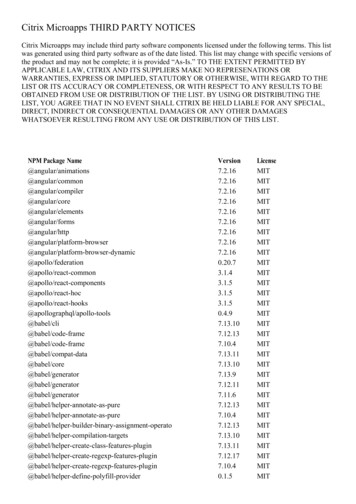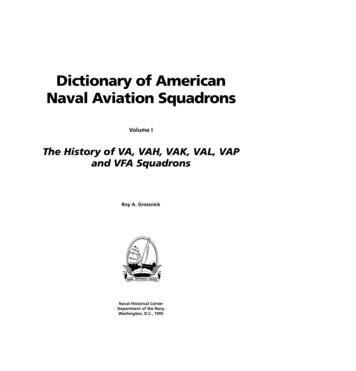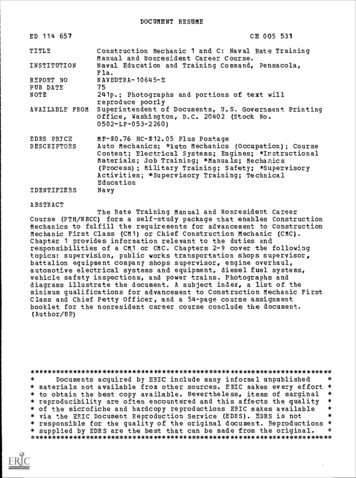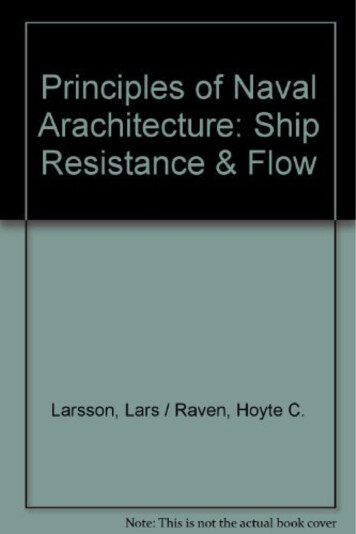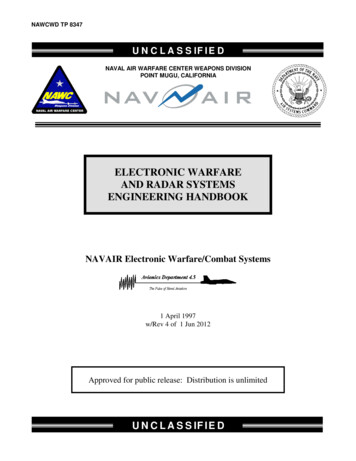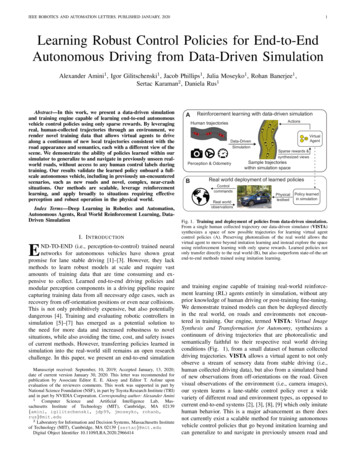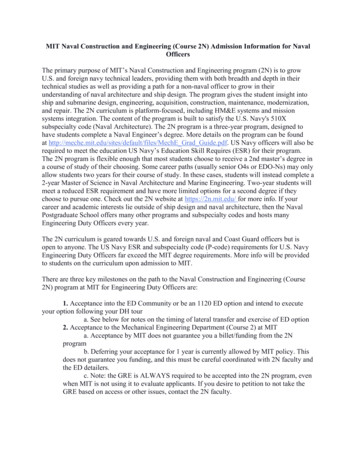
Transcription
MIT Naval Construction and Engineering (Course 2N) Admission Information for NavalOfficersThe primary purpose of MIT’s Naval Construction and Engineering program (2N) is to growU.S. and foreign navy technical leaders, providing them with both breadth and depth in theirtechnical studies as well as providing a path for a non-naval officer to grow in theirunderstanding of naval architecture and ship design. The program gives the student insight intoship and submarine design, engineering, acquisition, construction, maintenance, modernization,and repair. The 2N curriculum is platform-focused, including HM&E systems and missionsystems integration. The content of the program is built to satisfy the U.S. Navy's 510Xsubspecialty code (Naval Architecture). The 2N program is a three-year program, designed tohave students complete a Naval Engineer’s degree. More details on the program can be foundat http://meche.mit.edu/sites/default/files/MechE Grad Guide.pdf. US Navy officers will also berequired to meet the education US Navy’s Education Skill Requires (ESR) for their program.The 2N program is flexible enough that most students choose to receive a 2nd master’s degree ina course of study of their choosing. Some career paths (usually senior O4s or EDO-Ns) may onlyallow students two years for their course of study. In these cases, students will instead complete a2‐year Master of Science in Naval Architecture and Marine Engineering. Two-year students willmeet a reduced ESR requirement and have more limited options for a second degree if theychoose to pursue one. Check out the 2N website at https://2n.mit.edu/ for more info. If yourcareer and academic interests lie outside of ship design and naval architecture, then the NavalPostgraduate School offers many other programs and subspecialty codes and hosts manyEngineering Duty Officers every year.The 2N curriculum is geared towards U.S. and foreign naval and Coast Guard officers but isopen to anyone. The US Navy ESR and subspecialty code (P-code) requirements for U.S. NavyEngineering Duty Officers far exceed the MIT degree requirements. More info will be providedto students on the curriculum upon admission to MIT.There are three key milestones on the path to the Naval Construction and Engineering (Course2N) program at MIT for Engineering Duty Officers are:1. Acceptance into the ED Community or be an 1120 ED option and intend to executeyour option following your DH toura. See below for notes on the timing of lateral transfer and exercise of ED option2. Acceptance to the Mechanical Engineering Department (Course 2) at MITa. Acceptance by MIT does not guarantee you a billet/funding from the 2Nprogramb. Deferring your acceptance for 1 year is currently allowed by MIT policy. Thisdoes not guarantee you funding, and this must be careful coordinated with 2N faculty andthe ED detailers.c. Note: the GRE is ALWAYS required to be accepted into the 2N program, evenwhen MIT is not using it to evaluate applicants. If you desire to petition to not take theGRE based on access or other issues, contact the 2N faculty.
3. Securing one of the 2N billets available each year (for USN officers)a. 2N faculty work with the detailer to allocate billets from the pool of acceptedstudentsb. The 2N program fully funds billeted studentsc. Currently there are nine billets for 2N and one billet for a course 22 (Nuclear)candidate; if not filled the course 22 funding may be offered to a tenth 2N student whowill be on 2-year orders. Acceptance by MIT does not guarantee funding by the EDcommunity.4. Most foreign Navy Officers are funded by their Navy.5. USCG officers typically need sponsorship from MIT faculty to cover funding.6. If you need help with funding please contact the 2N faculty.USN officers may apply to MIT prior to becoming an ED (anyone is always welcome to apply toMIT!). However, officers will not get orders from the ED community to go to MIT until a lateraltransfer occurs or an ED option is exercised. If you are not an Engineering Duty Officer, but anofficer of a different community and interested in the 2N program, please contact the 2N faculty.The MIT application deadline is usually in early December, and the November lateral transferboard results are usually released in late December or early January.Notification of admission and subsequent detailing to MIT will occur in early February. The 2Nprogram begins in late May, so your PRD may have to be adjusted for a May arrival. Failure tocarefully coordinate all of these with 2N faculty and both your losing command and the EDdetailers may result in loss of funding. COMMUNICATE EARLY AND OFTEN!The application to the Mechanical Engineering Department at MIT is completed online. Theapplication usually is available by September 15th and must be completed by early December (itvaries year to year‐‐ usually either the 1st or 15th of the month—be sure you know which it is.)Paper applications are not accepted. Useful application links:ME Graduate Admission Home: chanical Engineering Department Admissionsinstructions: s/graduate/applyThe following are application best practices and pitfalls. The best practices are not minimumcriteria and are provided to help you maximize your chance at admission. The pitfalls are notdisqualifiers but are to be avoided if possible. Remember if you don’t apply you absolutely willnot be admitted! If you are interested in coming then you must apply! Give it your best shot, andcoordinate with the 2N faculty, specifically the Academic Officer (AO). Be sure to leaveyourself time to prepare for the GRE and retake it if needed. If you want some feedback prior toapplying, send your undergraduate school/degree/GPA and GRE scores to the 2N AcademicOfficer.
MIT 2N Application Best Practices (i.e., the “ideal” application does all of these)1. MIT always assesses the whole person. Everyone has a story. Your job in yourapplication is to tell your story to the admissions committee. The most important parts arequantifiable data: GPA, undergraduate degree, GRE scores, particularly the quantitative section,and hard breakouts in letters of recommendation (#1 of more than 100 officers I have workedwith).2. Make sure you can demonstrate that you have the academic ability to cut it at MIT. Ifyou did poorly in an area, try to demonstrate that you have the ability through other means.a. If you didn’t have a great undergraduate GPAi. Break out your technical, engineering, or in major GPA (if engineering or hardscience) to show that you excel in technical coursesii. Study and do well on the GRE. Be prepared to take it multiple times. Payparticular attention to the quantitative sectioniii. Show that you broke out academically in Navy schools (Nuclear Power school,SWOS, etc).iv. Take a community college course to show that you can succeed in thefoundational courses especially calculus.b. If you did not major in a technical areai. Demonstrate through your personal statement and letters of recommendation howyou are prepared to complete a course of study at the world’s premier technical university in theMechanical Engineering departmentii. Break out your technical courses, even if it’s just physics and calculusiii. Do well in the GRE particularly in the quantitative section.c. MIT is a research university. Anything you can do to show you are prepared to dotechnical research is helpful. Describing a technical senior project is better than not puttinganything in your application.3. Three concise, well‐written and current recommendation lettersa. Hard break outs helpb. You must have 3 letters. If you only submit two, your application will beincomplete and never make it to admissions.c. At least one letter must be from academia. Professors that oversaw research areexcellent, but any faculty letter will do. Explicitly ranking you higher than most of yourpeers and commenting on your ability to conduct research and succeed at MIT is a bestpractice.d. At least one from your Navy chain-of-command that explicitly comments onyour surety of success at MIT (your drive/dedication/work ethic/performance/etc.) andyour outstanding performance and the confidence you have inspired with yourperformance of duties. Hard break outs matter. Not having a letter from your currentchain of command invites a lot of questions.e. The third letter is preferred to be from academia, but there is flexibility hereespecially for those who have been out of school for some time.f. Specific comments on undergraduate or other research projects you havecompleted should show up in as many letters as make sense for the authors.
4. Concise, well‐written personal statement that stands out by providing a detailed andspecific account of an event/project that gives the reader insight into (some or all of) theapplicant’sa. ability to succeed academicallyb. research interestsc. personal motivationsd. other broadening factors (community service, foreign travel/study, internships)5. Complete application including letters of reference and GRE scores submitted by thedeadline are a MUST6. Communication with 2N Academic Officer (AO) well prior to application deadlinea. This helps to ensure your application is complete and routed through the MITadmissions process smoothly and correctly.b. If you have communicated to the AO ahead of time and your package does notmake it to admissions, the academic officer will go find it. If you have notcommunicated, you will not be evaluated for admissions and never get any feedback.Don’t let this happen to you.c. Failure to do this has resulted in mismarked applications being rejected bydepartments and programs other than 2N without the Navy even knowing; the 2N facultyare your strongest advocates and your most likely path to acceptance and billeting!MIT 2N Application Practices to Avoid (not disqualifiers)1. Personal statement points out everything that is wrong with current navy ships/policiesand indicates that the applicant will fix them once they have graduated from MIT.2. Typos, misspellings, poor grammar. Have someone else read your statement. IfEnglish is not your primary language, have a native English speaker read it.
MIT Application Guidance1) Application Informationa) First research field of interest: Naval Engineeringb) Second and Third: anything you wantc) Initial/Final degree objective: Naval Engineer (3-yr) or SM (2-yr)2) Letters of Recommendation (See also 2Ninfo and Application Gouge document)a) MUST have three letters or package will likely never get evaluatedb) One letter NEEDS to be from someone in your Academic backgroundc) One letter from your existing chain of command is highly advisedd) Make sure to address academic ability as much as possible instead of typical officer stuff thatthe general faculty here may not be able to translate into academic acumen3) Personal Informationa) All self-explanatory4) Race / Ethnicitya) Self-explanatory5) Sexual Orientationa) Self-explanatory6) Addressesa) No FPO/APs, please7) Colleges/Universities Attendeda) Make sure what you report matches your transcriptb) Official transcript not needed until after admittance, so you don’t need to pay for official oneinitially, can use the (typically) free unofficial transcriptsc) Make sure to check for PII (like SSN) and redact as necessary8) Test Scores / Experience / Electronic Portfolioa) Grading system typically not needed or required as long as it is spelled out on the transcripts oris standard (4.0 scale with 90% A, etc )b) Take the General GRE as soon as possible. You are allowed to take it more than once, and wetake your best score.i) You can be reimbursed by the Navy once for the test. See NPS’s website for -informationc) Fill out honors, publications, and experience to the best of your abilityi) Remember that these are mostly academics that don’t have deep knowledge of the armedforces, so acronyms and jobs need to be clear (like how LinkedIn or other services willprovide translators between military jobs and civilian equivalents).ii) Do not include all the citations for all your medals. I’m going to be honest: we don’t readthem if you do. Summarize them. Super-brevity is key.d) Type the resume or attach it, but not both.e) Ignore electronic portfolio.9) Financial Supporta) Under “assured” put:i) Source: US Navy
10)11)12)13)14)ii) 1st Year amount: 50kiii) Start date: June 20xxiv) Number of semesters: 4 or 6 as appropriateSubjects Takena) Not needed if you upload your transcriptsStatement of Objectivesa) Type in or upload a pdf, not bothb) Make sure to address everything it asks for, and remember you are applying to be a NavalEngineerLeaders for Global Operations Supplement (Only applicants to LGO need to complete this page)a) IgnoreSupplemental Questionsa) IgnoreSubmit Applicationa) You can submit before your letters of recommendation arrive. We are able to continue toreceive them even after your application is complete.b) MIT has waived the application fee for active duty in the past, so make sure to contact ahead oftime to arrange that if it isn’t obvious how to do so.c) As active duty, you can apply for an application fee ity-initiatives/fee-waiver
U.S. and foreign navy technical leaders, providing them with both breadth and depth in their technical studies as well as providing a path for a non-naval officer to grow in their understanding of naval architecture and ship design. The program gives the student insight into . Test Scores / Experience / Electronic Portfolio a) Grading system .
